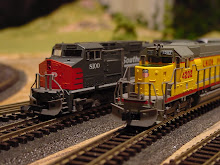Continued from: Transfer Table Staging
I plan to motorize the operation of my transfer table. There are many ways to do this. One option is to use a stepper motor to drive a screw and use a controller to set precise locations for each track index. This is a very advantageous approach as it provides great precision and you can control the speed, acceleration and deceleration of the drive mechanism. If you are interested in doing this, probably the simplest/cheapest option would be to use an Arduino board. They have examples for controlling a stepper motor and a full library for controlling stepper motors.
But, I didn’t want to deal with the complexity of electronics and controllers. So, I’m going to go with a network of switches and sensors.
Let me first start with what I want the end result to look like. I want to control the staging transfer table with a control panel that looks like this:
You turn the power on, and then select a track using the rotary switch. Then you move the table using the rocker switch. The table moves until the selected track is aligned and then it stops. When a track is aligned, it receives power, all other tracks are dead. The track that receives power is indicated with a lit LED on the control panel.
To achieve this, I'm going to use on/on DPDT switches for each table location. The reason why I want to use DPDT is because I want to use the same sensor/switch for supplying and shutting off power to the tracks. One pole of the DPDT will be used for the drive mechanism running 12v DC, and the other pole will be used for controlling the DCC power to the tracks which is AC.
The rotary switch is going to be used to select only one route for power to the actuator. The way I'll wire the DPDT switches will be so that it'll act like a normally closed circuit, as in current will flow only if the table isn't currently on that index. For example, I'll set the rotary switch to track 1. That means the only power path for the actuator goes through the DPDT sensor switch at position track 1. Now, if the table isn't currently aligned with track 1, the current will flow and I'll be able to operate the actuator using the rocker switch. Once the table aligns with track 1, then the DPDT sensor switch will throw and current won't flow. The only way one can move the table again is by selecting a different track with the rotary selector switch.
The reason why I decided to use DPDT sensor switches is as I said I wanted to be able to use the same switch for controlling track power. I needed the track power to be only on when the track is aligned and the drive power to be only off when the track is aligned.
Here’s the complete wiring diagram:
The only option for a DPDT sensor switch I could find was this:
http://search.digikey.com/us/en/prod...1418-ND/483974
So, I started looking for alternatives. One possibility is to use regular SPDT switches for the sensors, for which there is a wide variety, and SPST relays to control track power. I guess I have some tinkering to do.






No comments:
Post a Comment